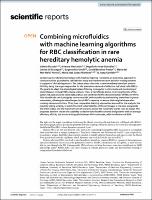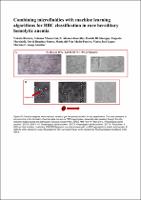| dc.contributor | Vall d'Hebron Barcelona Hospital Campus |
| dc.contributor.author | Rizzuto, Valeria |
| dc.contributor.author | Mencattini, Arianna |
| dc.contributor.author | Álvarez‑González, Begoña |
| dc.contributor.author | Di Giuseppe, Davide |
| dc.contributor.author | Martinelli, Eugenio |
| dc.contributor.author | Mañu Pereira, M Mar |
| dc.contributor.author | Beneitez Pastor, David |
| dc.date.accessioned | 2022-02-03T13:36:40Z |
| dc.date.available | 2022-02-03T13:36:40Z |
| dc.date.issued | 2021-06-30 |
| dc.identifier.citation | Rizzuto V, Mencattini A, Álvarez-González B, Di Giuseppe D, Martinelli E, Beneitez-Pastor D, et al. Combining microfluidics with machine learning algorithms for RBC classification in rare hereditary hemolytic anemia. Sci Rep. 2021 Jun 30;11:13553. |
| dc.identifier.issn | 2045-2322 |
| dc.identifier.uri | https://hdl.handle.net/11351/6972 |
| dc.description | Anaemia; Microfluidics; Sickle cell disease |
| dc.description.abstract | Combining microfluidics technology with machine learning represents an innovative approach to conduct massive quantitative cell behavior study and implement smart decision-making systems in support of clinical diagnostics. The spleen plays a key-role in rare hereditary hemolytic anemia (RHHA), being the organ responsible for the premature removal of defective red blood cells (RBCs). The goal is to adapt the physiological spleen filtering strategy for in vitro study and monitoring of blood diseases through RBCs shape analysis. Then, a microfluidic device mimicking the slits of the spleen red pulp area and video data analysis are combined for the characterization of RBCs in RHHA. This microfluidic unit is designed to evaluate RBC deformability by maintaining them fixed in planar orientation, allowing the visual inspection of RBC’s capacity to restore their original shape after crossing microconstrictions. Then, two cooperative learning approaches are used for the analysis: the majority voting scheme, in which the most voted label for all the cell images is the class assigned to the entire video; and the maximum sum of scores to decide the maximally scored class to assign. The proposed platform shows the capability to discriminate healthy controls and patients with an average efficiency of 91%, but also to distinguish between RHHA subtypes, with an efficiency of 82%. |
| dc.language.iso | eng |
| dc.publisher | Nature Research |
| dc.relation.ispartofseries | Scientific Reports;11 |
| dc.rights | Attribution 4.0 International |
| dc.rights.uri | http://creativecommons.org/licenses/by/4.0/ |
| dc.source | Scientia |
| dc.subject | Anèmia hemolítica - Diagnòstic |
| dc.subject | Microfluídica |
| dc.subject | Intel·ligència artificial |
| dc.subject.mesh | Anemia, Hemolytic, Congenital |
| dc.subject.mesh | Microfluidic Analytical Techniques |
| dc.subject.mesh | Machine Learning |
| dc.title | Combining microfluidics with machine learning algorithms for RBC classification in rare hereditary hemolytic anemia |
| dc.type | info:eu-repo/semantics/article |
| dc.identifier.doi | 10.1038/s41598-021-92747-2 |
| dc.subject.decs | anemia hemolítica congénita |
| dc.subject.decs | técnicas analíticas microfluídicas |
| dc.subject.decs | aprendizaje automático |
| dc.relation.publishversion | https://doi.org/10.1038/s41598-021-92747-2 |
| dc.type.version | info:eu-repo/semantics/publishedVersion |
| dc.audience | Professionals |
| dc.contributor.organismes | Institut Català de la Salut |
| dc.contributor.authoraffiliation | [Rizzuto V] Josep Carreras Leukaemia Research Institute (IJC), 08916 Badalona, Spain. Institute for Bioengineering of Catalonia (IBEC), Barcelona Institute of Science and Technology BIST, 08028 Barcelona, Spain. Department of Medicine, University of Barcelona, 08036 Barcelona, Spain. [Mencattini A, Di Giuseppe D, Martinelli E] Department of Electronic Engineering, University of Rome Tor Vergata, 00133 Rome, Italy. University of Rome Tor Vergata, Interdisciplinary Center for Advanced Studies on Lab-on-Chip and Organ-on-Chip Applications (ICLOC), 00133 Rome, Italy. [Álvarez-González B] Institute for Bioengineering of Catalonia (IBEC), Barcelona Institute of Science and Technology BIST, 08028 Barcelona, Spain. Centro de Investigacion Biomedica en Red en Bioingeniería, Biomateriales y Nanomedicina (CIBER-BBN), 28029 Madrid, Spain. [Beneitez-Pastor D] Unitat de Trastorns de Glòbuls Vermells, Servei d’Hematologia, Vall d’Hebron Hospital Universitari, Barcelona, Spain. Vall d’Hebron Institute of Oncology (VHIO), Barcelona, Spain. Grup de Recerca Translacional en Càncer en la Infància i l’Adolescència, Línia de recerca de Trastorns d'Anèmia Rara, Vall d’Hebron Institut de Recerca (VHIR), Barcelona, Spain. ERN-EuroBloodNet Member, 08035 Barcelona, Spain. [Mañú-Pereira MDM] Grup de Recerca Translacional en Càncer en la Infància i l’Adolescència, Línia de recerca de Trastorns d'Anèmia Rara, Vall d’Hebron Institut de Recerca (VHIR), Barcelona, Spain. ERN-EuroBloodNet Member, 08035 Barcelona, Spain. |
| dc.identifier.pmid | 34193899 |
| dc.identifier.wos | 000671789900006 |
| dc.rights.accessrights | info:eu-repo/semantics/openAccess |


